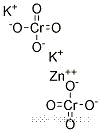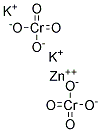Base Information
Edit
- Chemical Name:ZINC potassium chromate
- CAS No.:37224-57-0
- Deprecated CAS:12527-08-1,37809-34-0,37809-34-0
- Molecular Formula:Cr2K2O8Zn
- Molecular Weight:375.574
- Hs Code.:
- European Community (EC) Number:234-329-8
- ICSC Number:1775
- DSSTox Substance ID:DTXSID2026313
- Mol file:37224-57-0.mol

Synonyms:ZINC POTASSIUM CHROMATE;11103-86-9;Potassium zinc chromate hydroxide;Potassium zinc chromate;Potassium hydroxyoctaoxodizincatedichromate(1-);CCRIS 4743;HSDB 1060;EINECS 234-329-8;Potassium zinc chromate hydroxide (KZn2(CrO4)2(OH));Chromic acid, potassium zinc salt (2:2:1);potassium;dizinc;dioxido(dioxo)chromium;hydroxide;Chromate(1-), hydroxyoctaoxodizincatedi-, potassium;37224-57-0;EC 234-329-8;CrO4.HO.K.Zn;Cr2HO9Zn2.K;Cr-O4.H-O.K.Zn;DTXSID2026313;LS-2090




